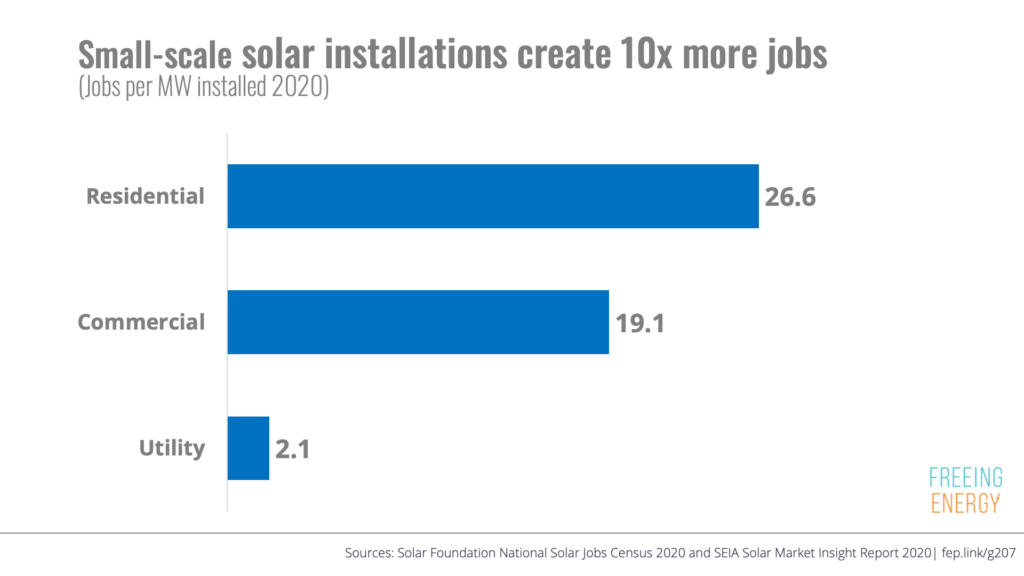 Solar power creates a lot of jobs, more than any other type of energy (see how they compare here). But some types of solar projects create a lot more jobs than others. According to the Solar Foundation National Solar Jobs Census for 2020, small-scale solar projects, including residential, commercial, and community solar, supported a total of 124,594 jobs in 2020. Utility-scale installations only supported 30,017 jobs. This job creating power of small-scale “local energy” projects is even more pronounced if we look at how much solar is being built. In 2020, the Solar Energy Industries Association (SEIA) recorded 5,268 megawatts installed through local solar projects. That means there were 23.7 local energy jobs per megawatt installed. In comparison, there were 14,000 megawatts of utility-scale solar installed in 2020 for a total of 2.1 utility energy jobs per megawatt, one-tenth of the 23.7 jobs created by local solar projects.
Solar power creates a lot of jobs, more than any other type of energy (see how they compare here). But some types of solar projects create a lot more jobs than others. According to the Solar Foundation National Solar Jobs Census for 2020, small-scale solar projects, including residential, commercial, and community solar, supported a total of 124,594 jobs in 2020. Utility-scale installations only supported 30,017 jobs. This job creating power of small-scale “local energy” projects is even more pronounced if we look at how much solar is being built. In 2020, the Solar Energy Industries Association (SEIA) recorded 5,268 megawatts installed through local solar projects. That means there were 23.7 local energy jobs per megawatt installed. In comparison, there were 14,000 megawatts of utility-scale solar installed in 2020 for a total of 2.1 utility energy jobs per megawatt, one-tenth of the 23.7 jobs created by local solar projects.
30 Million Solar Homes
Just how many jobs can local energy create? A recent report by ILSR and SUN called The National Impact of 30 Million Solar Homes: A Vision for an Equitable Economic Recovery Built on Climate Protection and Energy Democracy provides an exciting answer (make sure to check out our podcast with the leaders of both of these great firms: Anya Schoolman (SUN) and John Farrell (ILSR)). According to the report, adding rooftop solar to 30 million homes will create 1.77 million new jobs and reduce energy bills by $69 billion within the first 6 years. In addition, the amount of air pollution avoided would be equivalent to closing 48-coal burning power plants or taking 42 million cars off the road for a year. But 30 Million Homes and its sponsors have another mission, which is to help low-income families benefit from solar via the long-term financial relief it provides through granting them energy independence. This is significant because the federal government currently spends billions of dollars a year to help low-income families pay their energy bills, yet this approach aids less than 20% of the eligible population. Under the 30 Million Homes plan, 100 gigawatts of the total 151 gigawatts of new solar capacity installed would be placed in marginalized communities, providing power to approximately 20 million low income households.
The Freeing Energy Perspective
The world needs every bit of clean energy it can get. Whether it is solar, wind, geothermal, or other cost-competitive renewable sources of electricity, the race to replace fossil fuels needs to move much faster. But small-scale solar systems are often overlooked or marginalized as huge opportunities to further accelerate the transition to clean energy. Small-scale “local energy” systems create far more jobs, most of which are in the same communities where the electricity is generated. They are also far more resilient and small-scale systems are actually the best way to reduce the energy bills of customers and local businesses. To learn more about why local solar is often cheaper than utility solar for consumers, check out our article “Is utility-scale solar actually cheaper than local solar?” for more information.
Further Reading & Listening
Institute for Local Self-Reliance Report – 30 Million Homes Energy Fact – Building a residential rooftop solar project is cheaper than grid electricity. Freeing Energy Podcast, episode #57: John Farrell & ILSR – Monopoly utilities and consumers are headed for collision over local energy. The rules must change, but how? Freeing Energy Podcast, episode #17: Anya Schoolman & SUN – Can we change the future of energy at the community level?



